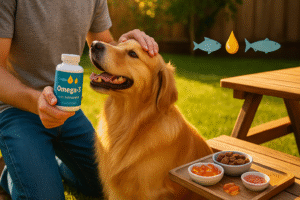Medical Disclaimer: This article is for informational purposes only and does not replace personalized veterinary advice. Consult your vet before introducing new foods.
Table of Contents
Ever watched your dog eye your fruit bowl with curiosity? As a practicing small-animal vet in Ottawa, I’ve had plenty of clients ask me: “Can dogs eat mango?” The short answer is yes — but only when served safely. I’ve seen both happy tails and emergency vet visits involving this tropical fruit. Let’s walk through what you need to know to treat your pup smartly — and avoid a trip to the ER.
✅ Key Takeaways: Mango for Dogs at a Glance
- Yes, dogs https://www.akc.org/expert-advice/nutrition/can-dogs-eat-mango/can eat mango — but only the peeled, pit-free, ripe flesh and in moderation.
- Health benefits include vitamin A, vitamin C, antioxidants, and fiber.
- Always avoid the pit and skin — pits can cause choking or intestinal blockage, and the skin is tough to digest.
- Portion control matters: Too much mango can upset your dog’s stomach or spike blood sugar.
- Puppies under 3–4 months should not eat mango; older pups can try small, soft amounts.
- Vet tip: Treats like mango should make up less than 10% of your dog’s daily calories.
Is Mango Safe for Dogs to Eat?
Yes — but with a few key caveats. Mango can be a nutritious treat for most dogs when offered the right way. It’s packed with:
- Vitamin A – supports eye health, skin, and immune function
- Vitamin C – an antioxidant that helps aging dogs combat inflammation
- Fibre – aids digestion and stool quality
- Natural enzymes – can help break down proteins in the diet

But mango is also high in natural sugar. That’s not a problem for healthy dogs if offered in moderation — but if your dog has diabetes, pancreatitis, or is overweight, it’s a fruit you’ll want to limit or avoid altogether.
Portion Control Is Everything
Even for healthy dogs, mango is best served in small amounts. Think of it as a special occasion treat, not an everyday snack.
| Dog Size | Safe Mango Portion | Frequency |
|---|---|---|
| Small (<10 kg) | 1–2 small cubes | Once or twice/week |
| Medium (10–25 kg) | 2–3 cubes | Once or twice/week |
| Large (>25 kg) | 3–4 cubes | Once or twice/week |
Start with a small piece to check for any signs of intolerance — like vomiting, loose stool, or itching.
Vet Case Study: When Mango Goes Wrong
Every summer, someone walks into my clinic with a fruit-related emergency. One memorable case involved “Buddy,” a four-year-old Labrador retriever in Toronto. His family had been enjoying fresh mango and figured Buddy could too — so they gave him the whole fruit.
What they didn’t know? Mango pits are not only inedible but dangerous.
Buddy’s Emergency
Within hours, Buddy began vomiting and showed signs of abdominal discomfort. An X-ray revealed the pit had lodged in his intestines, causing a partial blockage. We performed emergency surgery to remove it — and thankfully, Buddy recovered well.
Takeaway from This Case
Even something healthy like mango can be hazardous when not prepared correctly. Always remove the pit completely, and never let your dog access a whole mango unattended.
How to Feed Mango Safely to Dogs
As a vet, I often remind clients that how you feed mango is just as important as whether you feed it. Here’s my safe-feeding checklist, based on what I share in-clinic:
🥭 Step-by-Step Mango Prep for Dogs
- Wash thoroughly – remove any pesticide or residue from the skin
- Peel the fruit – mango skin is fibrous and tough for dogs to digest
- Remove the pit completely – pits can cause obstructions or tooth damage
- Cut into small cubes – adjust the size based on your dog’s size
- Serve chilled or at room temperature – both are safe
💡 Tip: Try freezing the cubes for a summer treat!

📝 Safe Mango Feeding Checklist
| Step | Why It Matters |
|---|---|
| Wash and peel the mango | Reduces chemical risk and improves digestibility |
| Remove the pit entirely | Prevents choking or intestinal blockage |
| Portion by dog’s size | Avoids overfeeding and sugar overload |
| Serve fresh, not dried | Dried mango is too sugary and sticky |
| Supervise during first taste | Monitor for any allergic reaction |
Mango should never make up more than 10% of your dog’s daily calories.
Mango for Puppies — Yes or No?
Puppies have developing digestive systems that aren’t ready for high-sugar or high-fibre foods in the early weeks. That’s why I typically advise pet parents to wait until 3–4 months of age before introducing mango — or any fruit.
When to Offer Mango to a Puppy
- After 12–16 weeks: Once weaned, vaccinated, and on stable puppy food
- In small, soft pieces only: A sliver of ripe mango or a lick of purée is enough
- No peels or pits: Puppies are more likely to choke or have GI issues
Start slow. If your pup shows signs of gas, soft stool, or hyperactivity, back off on fruit entirely. You can always try again later — with your vet’s okay.
💡 Bonus tip: For teething relief, freeze a tiny cube of puréed mango in a rubber toy.
Mango Dangers: What to Watch Out For
Despite its health perks, mango can pose real risks if handled carelessly. In my practice, I’ve treated dogs for everything from choking on pits to sugar-induced diarrhea.
Here’s a breakdown of the top red flags:
⚠️ Common Mango Hazards for Dogs
| Danger | Why It’s a Problem |
|---|---|
| Pit (seed) | Choking risk or intestinal blockage; contains cyanide traces |
| Skin | Tough to digest and may carry pesticides or residues |
| Too much sugar | Can trigger GI upset, weight gain, or spike blood sugar |
| Dried mango | High in sugar and often contains preservatives |
| Allergic reaction | Rare, but includes symptoms like itching, swelling, vomiting |
If your dog reacts poorly to mango, stop immediately and contact your vet. Watch for:
- Vomiting or diarrhea
- Itchy skin or hives
- Swelling around mouth or eyes
- Sudden changes in energy or appetite
Even healthy treats can backfire without portion control and proper prep.
Frequently Asked Questions About Dogs and Mango
Q: Can diabetic dogs eat mango?
A: I generally recommend against it. Even though mango is natural, its sugar content can cause blood glucose spikes. If your dog is diabetic and you’re considering fruit, talk to your vet first — we might recommend safer alternatives like cucumber or green beans.
Q: Can I use mango in homemade dog treats?
A: Yes — and I often encourage it, with some caveats. Mango pairs well with ingredients like plain Greek yogurt, oats, or pumpkin. Avoid anything with added sugars, dairy (for sensitive dogs), or wheat (if your dog has allergies).
Q: My dog accidentally ate a mango pit — what should I do?
A: Call your vet immediately. Depending on your dog’s size and whether the pit was chewed or swallowed whole, we may need to do imaging (like an X-ray) to check for obstruction. Don’t wait for symptoms to show — time matters.

Bonus: Vet-Approved Mango Dog Treat Recipes
Mango isn’t just safe — it can also be a fun enrichment tool when used creatively. Here are two of my go-to recipes I share with clients in the summer months:
🧊 Frozen Mango Cubes
Ingredients:
- ½ cup ripe mango (peeled, chopped)
- Water or no-sodium chicken broth
Instructions:
- Purée mango in a blender
- Add a splash of water or broth for smoother texture
- Pour into ice cube trays or silicone moulds
- Freeze for 3–4 hours
- Serve as an occasional treat on hot days
🍦 Mango & Yogurt Swirl
Ingredients:
- ¼ cup plain Greek yogurt (no xylitol)
- ¼ cup mango purée
Instructions:
- Swirl yogurt and mango together in small moulds
- Freeze and serve in moderation
- Great for enrichment toys like KONGs
✅ Vet tip: Stick to one or two cubes at a time. These should not replace meals.
Final Vet Advice on Mango Feeding
As a Canadian veterinarian, I’m all for sharing real, whole foods with our dogs — when it’s done responsibly. Mango can absolutely be part of that, as long as you follow what I call the Mango Rulebook:
🩺 The Mango Rulebook
- Know your dog’s health status — especially if they have diabetes, pancreatitis, or allergies
- Always peel and pit the mango — no exceptions
- Feed in moderation — no more than 10% of daily calories from treats
- Skip dried mango — it’s too sugary and often has preservatives
- Watch for signs of trouble — vomiting, diarrhea, itching, or behaviour changes
And remember: Not every dog needs mango in their life. If your pup turns up their nose or reacts poorly, skip it. There are plenty of other vet-approved treats out there.
Final Thought: When in doubt, reach out. Your local vet (or someone like me!) is always happy to guide you on what’s safe for your dog’s bowl. Because smart treats = happy, healthy dogs. 🍁🐾





Pingback: Can Dogs Eat Avocado? Vet Advice on Safety & Risks 101